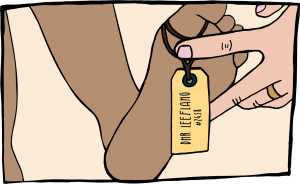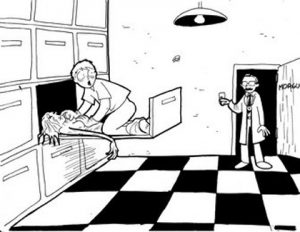necrophilia

Necrophilia is sexual desire in combination with a dead body.
The phenomenon has a very simple explanation. People in all kinds of professions have to deal with corpses: pathologists, doctors and nurses, morticians, gravediggers. Moreover, the deceased are naturally surrounded by loved ones, relatives, friends and acquaintances. Not more than a few hundred years ago, death was a frequent characteristic of daily life. Bad sanitary conditions, contagious diseases, poverty and need, conflict and war caused many to die at a young age. The presence of a youthful corpse, which is completely passively available in all its beauty and which won’t resist and cannot be hurt, can easily bring about strong feelings of lust which are then satisfied by touching and masturbation or intercourse.
Necrophilia and the graveyard
Necrophilia is mostly associated with men who visit the graveyard at night, dig up the body of a young virgin just buried and satisfy their lust. They are sometimes caught and used to be harshly punished. Society has a horror of necrophilia, because it is felt to be a desecration of the dead, even though the dead cannot feel anything. Probably the strong collective disapproval is also inspired by secret guilt: most men secretly have the same desire.
Men -and women too- have sexual fantasies about a completely passive and willing object, and sometimes want their partner to lie completely still during sex. The fantasy about and enjoyment of a passive partner must find its origin in the first years of conscious sexual longing. In youth, when boys fall in love with a girl (or a boy), who is out of reach, they imagine or dream that all barriers of resistance are broken down and the object of their love is completely available and willing. Pornography partly satisfies this desire, and also prostitutes tell of clients who like to stage a deathbed scene, in which the girl is required to lie still like a corpse.
The history of necrophilia
Men who were caught during necrophiliac activities (usually by someone they knew, for instance their partner) were treated as serious criminals and usually received cruel punishment. Nowadays, the violation of a corpse is still registered as a moral offence in the criminal code. The suspicion of sexual activity was a primary reason to prohibit scientific anatomical research with corpses (therefore Leonardo da Vinci was forced to dig up dead bodies from the cemetery in secret). The term ‘necrophilia’ came into use during the nineteenth century when psychiatry entered legal proceedings. Just as with the other sexual varieties, necrophiliacs became a separate category of mental patient, labelled as ‘sexual deviant’. Psychiatrists tried to find out what caused this so-called abnormality or perversity, even though the actual crime was nothing more than a violation of what was called ‘public order’, even though in most cases, there was nothing public about their act either, and no actual harm was done. Due to the influence of the medical men, necrophilia became one of the ‘perversions’ that needed to be treated and from which the public must be screened and protected. Since the people who were caught were generally fearful and confused, lonely, socially clumsy or came from the lowest strata of men (who were unsuccessful in finding a woman for themselves), they were described as primitive and degenerate. Anatomical evidence mentioned low foreheads, stocky figures, crooked gait, rachitic appearance and slurred speech. All such characteristics became typical for the sexual pervert in general, and were equally applied to many other varieties of sexual expression.

